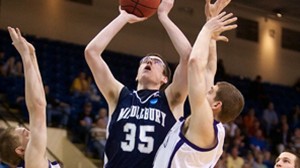
Ryan Sharry scored 41 points against RPI in 2011 on 19-23 shooting, largely on minimally contested shots around the basket.
After a tough 0-2 weekend at the Hoopsville Classic, the Panthers travel to Rensselaer for the first of five non-conference games before NESCAC season tips off on January 10th. The Engineers lost their top three scorers from a 17-10 squad last season, and have started off 2013-14 with three consecutive losses. RPI runs a modified Grinnell offense, in which they often pressure the ball with a full-court press, take chances on defense, look to shoot early in the shot clock, and substitute wholesale lines every few minutes. This leads to an often frantic tempo and creates unusual stat lines and tons of scoring. This is the team against which Middlebury scored a team record 123 points in 2012, that usually plays 15 players for double-digit minutes, and that allowed Pete Lynch and James Jensen a combined 39 points in last year’s matchup. As it has been each of the past few years, the RPI game will be intriguing and will probably produce a few box score surprises.
While Middlebury will be forced to adjust because of RPI’s style of play, there is little reason to believe that they will not win by virtue of being the better team. It might take some time to get accustomed to the pace of play, but RPI’s defense is porous, its offense is inefficient, and Middlebury can make more of their possessions because of the disparity in both size and talent. In last year’s matchup, Middlebury won 105-86, shooting 57% from the field and getting a lot of open looks around the basket. This season, one area of emphasis has been the fast-break, with coach Brown imploring his players to push the ball up the court after defensive rebounds. We have seen several big runs so far this season behind that style of play, pushing the tempo and taking it to basket, and we expect Middlebury to excel in transition Sunday. Jake Brown and Joey Kizel are both capable of leading the break and there is enough depth and athleticism around them to run with the substitution-heavy Engineers.
That said, one area of weakness so far for Middlebury has been passing. On several occasions last weekend, a pass back to a guard was telegraphed, thrown weakly and intercepted, leading to a fast-break layup. In particular, Middlebury’s bigs were casual with the basketball when they initiated the offense at the top of the key. Rensselaer will sell out trying to make plays on similar passes, so it will be on the Panthers to show they have learned quickly, and be more aware in those situations. In a game like this, inexperienced players (of which Middlebury has several) need to show that they are heady and can make good decisions in unexpected or chaotic situations. Because of RPI’s aggression, this matchup will be valuable for the players and instructive for the coaches. In 2012, Middlebury’s veteran-heavy squad limited RPI to four steals. This year, RPI comes in averaging 17 steals per game and will likely have more success than last year, but if it gets to double digits that should raise concerns about Middlebury’s savviness on the ball.
The rotation continues to be defined by moving pieces and the closer we get to conference play the fewer chances those on the outside are going to have to prove themselves. The only three guys who have started every game are Joey Kizel, Jack Roberts and Matt Daley. We expect one of the latter two to get pushed out by the return of James Jensen (likely in this game). Hunter Merryman’s play has earned him a start in every game since the season-opener, and he is likely to stick there. The other guard spot is going to come down to Matt St. Amour, Jake Brown and Nate Bulluck. If those eight are near-locks in the rotation, it doesn’t leave much room for the minutes of those behind them come conference play. Jake Nidenberg has scored efficiently (8.2 ppg, 70% FG in 16 mpg) and will stay in the rotation as long as he keeps that up. Henry Pendergast is battling an injury and should get an opportunity to play more on the ball in the coming weeks, which will determine his status going forward. Bryan Jones looks like he could be a strong contributor at point guard in the future but will likely only play if Pendergast’s injury keeps him out. Connor Huff, Chris Churchill, and Dean Brierly have all shown enough to play situationally, but will need some statement play this month to earn rotation minutes. For those three guys in particular, the deeper rotation against RPI will give them another opportunity to make their case, but coach Brown will likely solidify his rotation by the time NESCAC play rolls around, so opportunities to earn increased minutes are becoming sparse.